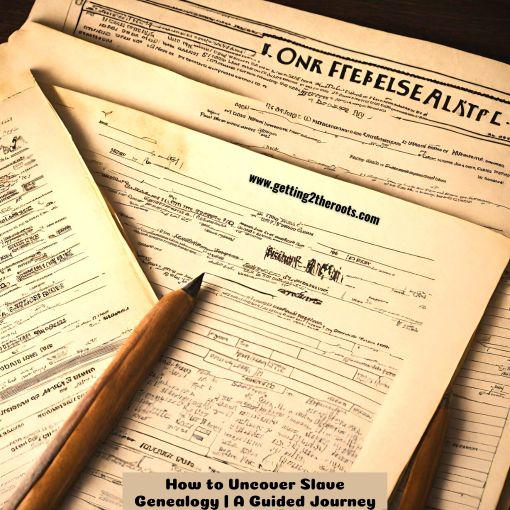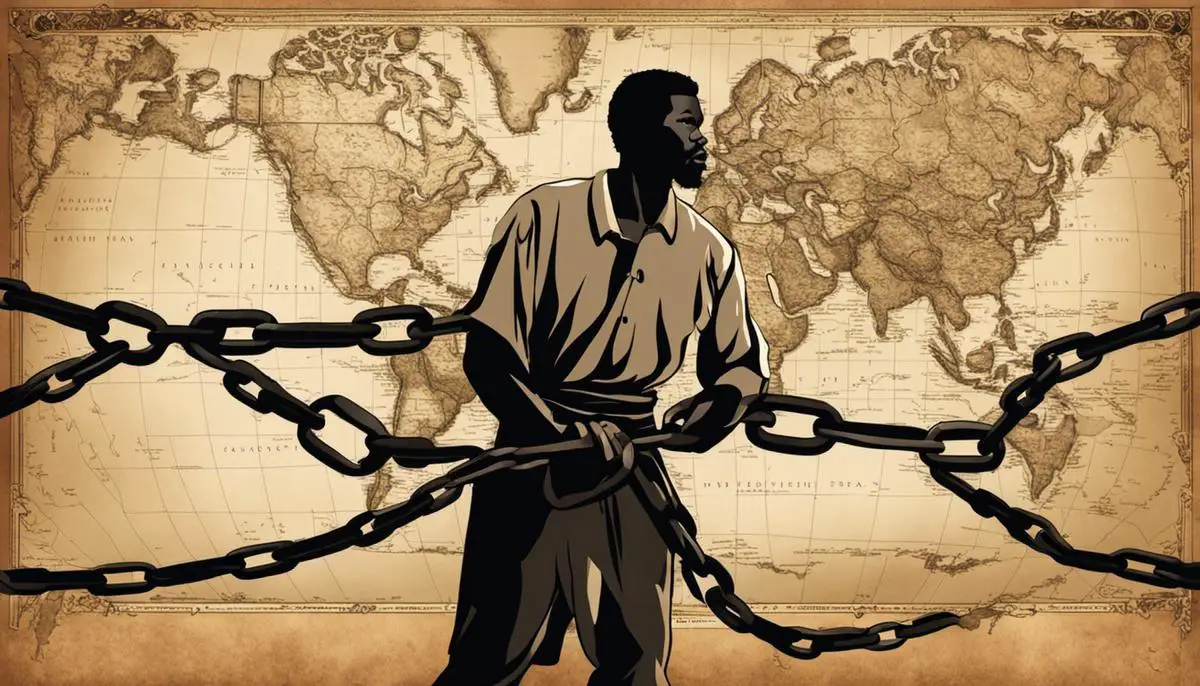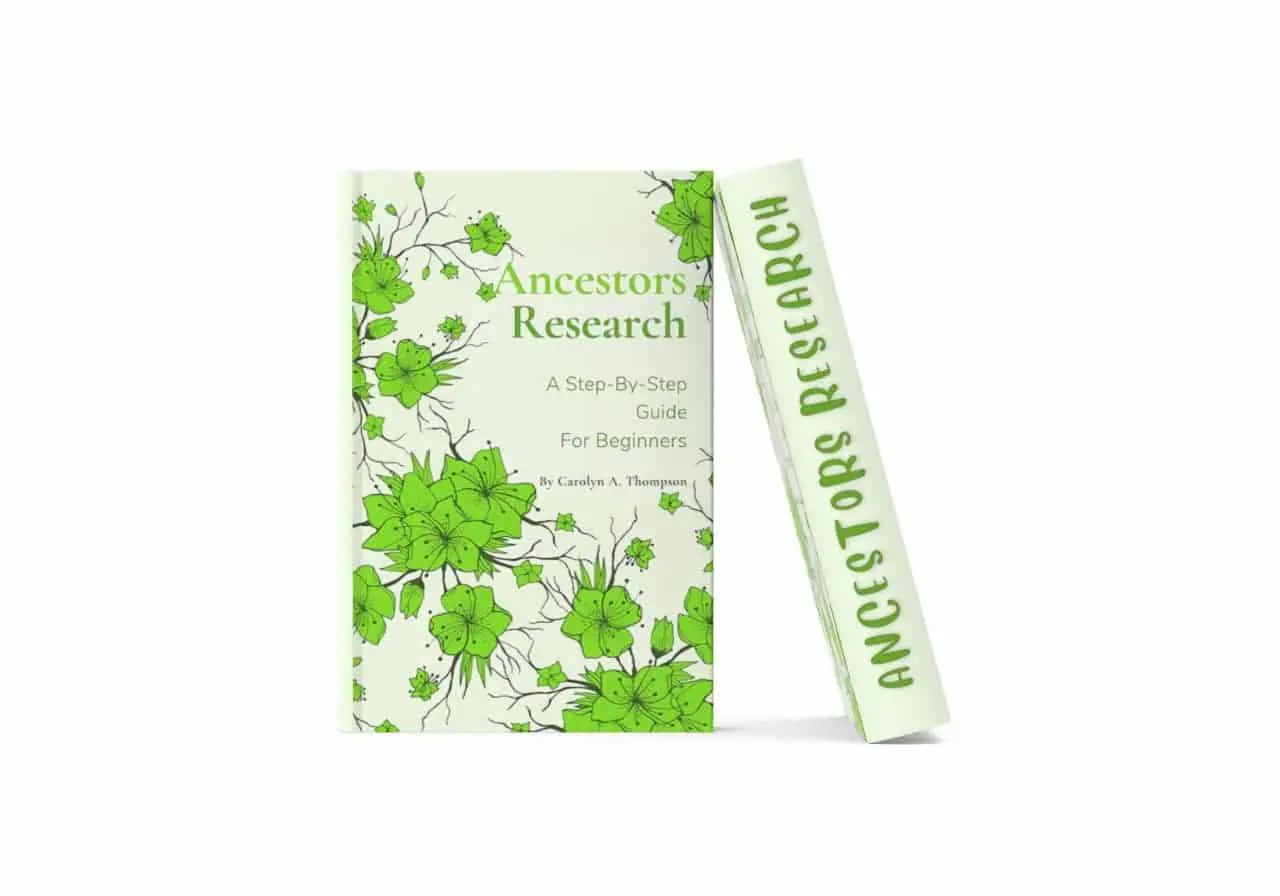Exploring the tapestry of slave genealogy involves journeying through bygone eras, gleaning valuable insights, and drawing profound connections to who we are today.
Nowhere does this quest for self-discovery become more challenging and rewarding than in the study of slave genealogy.
This monumental journey traces the legacy of slaves who helped shape America.
- Negotiating a complex maze of historical.
- Uncertainties.
- Scant documentation.
- Sociocultural disparities.
Unraveling the narratives ensnared within this labyrinth, we shed light on the historical context of slavery in America.
The process has become problematic and unreliable due to the presence of inadequate and racially biased documentation.
I encourage you to read my article, “Ancestors’ Research | Free Beginner’s Guide,” for helpful tips on organizing a memorable family gathering. [Click Here]
✨ Check Out My Go-To Tools And Resources:
Visit my new Resources Page to see the tools, resources, and companies I use and recommend for my website and YouTube channel. Curated for efficiency and creativity.
👉 Explore: [Tools And Resources]
Historical Context of Slavery in America
Disentangling Bonds: The Historical Context and Intrinsic Complexity of Slave Genealogy Research in America
The undertaking of genealogical research in any context presents its own inherent complexities.
It requires the unraveling of multi-generational threads intricately woven through the fabric of history.
In the context of the United States, this task compounds with the addition of a dark and tumultuous chapter: chattel slavery.
When delving into the study of slave genealogy, researchers encounter a myriad of obstructions.
And the challenges that demand recourse to meticulous scrutiny and deft navigation of archival content.
Historically, the institution of slavery in America spanned over two centuries, from the early 17th century through the end of the Civil War in 1865.
This long-lasting and widespread practice left an indelible scar on the nation’s history, as millions of African souls were ruthlessly stripped of their homelands, names, and identities.
Wrapped in this dehumanizing practice were systemic efforts to obliterate familial bonds and personal histories, making genealogical research in this area a labyrinthine task.
The first port of call for researchers seeking to trace slave lineage is often U.S. federal census records. Until 1870, however, these documents only recorded the names of slaveholders.
While enslaved individuals were typically enumerated without names, this practice complicates the identification of ancestors.
Moreover, the lack of preserved African names due to forced renaming further limits the tracing of lineage back to African roots.
Slaveholders’ records, including wills, estate inventories, and deeds, offer another potential source of slave genealogical data.
These records may document names, ages, and occasionally familial relationships. Hence, it provides significant insight into slave families.
However, access to these records is challenging due to their private nature and uneven preservation. Another rich, albeit arduous, avenue for exploration is oral history.
Passed down across generations, these narratives hold authentic personal histories. Yet, the resilience of memory and the passage of time can blur the fine details.
Thereby introducing potential inaccuracies that researchers must handle circumspectingly.
Additionally, genetic study advances, specifically in the field of DNA analysis, have provided a boon to the exploration of African ancestry.
These approaches are not without their limitations, though, as genetic markers alone can’t capture and reconstruct the fullness of historical and familial narratives.
All these complexities underscore the massive, multidimensional jigsaw puzzle that is slave genealogy research.
Each piece—be it census data, private records, oral history, or genetic information—needs to be meticulously evaluated.
And painstakingly placed to create a coherent picture of a family’s past. Alongside its inherent academic merit, slave genealogy contributes significantly to the broader;
- Discourse on identity.
- Heritage.
- And reconciliation in America.
- Underscoring its fundamental importance in a wider interdisciplinary context.
While challenging, the endeavor to reclaim these once-obscured threads of ancestry serves not just an academic or historical role.
It seeks to illuminate the shadowed past and honor the resilience of forebears. And repair the frayed tapestry of familial identity,
Weaving together a narrative tapestry that reflects both the heartbreaking history and abiding legacy of African people in the United States.

Challenges and Limitations in Slave Genealogy Research
Endeavoring Against the Odds: Delving Deeper into the Intricacies of Slave Genealogy Research in America
As scholars of history and humanity, we frequently grapple with challenges. Yet few are as demanding or complex as those encountered in the field of slave genealogy research in America.
Beyond the formidable obstacles and constraints already presented, researchers in this field grapple with a range of intricacies, each with its own series of impediments and limitations.
For instance, the fearfully frequent practice of renaming enslaved Africans upon arrival in America reveals one cloudy reality.
This act of erasure, which systematically detaches individuals from their identities and familial lineages in Africa, sets in motion a perplexing challenge.
Elucidating connections between the ancestral names, likely drawn from a diverse array of African languages.

And the Anglicized appellations given upon enslavement frequently become an uphill battle.
Moreover, in light of the involuntary geographic displacement and en masse transatlantic journeys, piecing together families is an intricate undertaking.
Internally, in America, slaves were often sold and moved at the whim of slaveholders, contributing to the depersonalization and dislocation of families.
Here, the daunting task becomes decoding the complex web of these internal relocations.
The process is problematic due to inadequate and racially biased documentation. Additionally, the scarcity of reliable public documentation presents another conundrum.
Notably, birth and death certificates, cornerstone records in conventional genealogy, were seldom, if ever, provided for slaves.
This gross lack of records further obscures the landscape of slave genealogy, creating a research area filled with invisible barriers.
Turning our focus to reparations, court records of emancipated slaves suing former masters for wages provide another source of genealogical information.
Despite this, those records are inherently limited in their usefulness due to the rarity of such suits and the inconsistent quality of record-keeping during the period.

Furthermore, the deciphering of the poignant accounts held in the narratives of former slaves, collected in the late 19th and early 20th centuries, is fraught with uncertainties.
These narratives, captured at sunset, of the lives of survivors of the darkest era in America’s past are invaluable.
Yet the chronological dislocation, misconstrued recollections, and subjective interpretations introduce an element of epistemological insecurity into the genealogical fabric.
Finally, a poignant, often overlooked complication in our quest for clarity is the tragic reality of the sexual exploitation of enslaved women by their masters.
These interactions create mixed-race children and further weave together black and white family trees, creating a complicated and emotionally charged path to explore.
Indeed, navigating the arduous path of slave genealogy research is like traversing a labyrinth of uncertainties.
Yet, its value, anchored both in a thirst for historical truth and the healing potential for descendants of slaves, can never be overstated.
Despite its limitations, it represents a determined effort to shed light on a long-obscured story and untangle human threads entangled by an inhumane past.

Methodologies and Techniques in Slave Genealogy Research
An Intriguing Avenue: Unearthing Lineage from Slavery using Challenged and Newfound Artifacts
The realm of slave genealogy research presents a paradoxical blend of rich history and mournful data shortages.
However, beneath the arduous task lies a committed endeavor to unearth truths and heal the breaches in the historical narrative.
As a challenging yet rewarding field of study, the pursuit of fruitful methodologies to enhance our understanding perpetually evolves.
- Unconventional records and artifacts.
- Plantation inventories.
- Property deeds.
- Wills.
- Probate records.
- Bills of sale.
Step into the spotlight once we cross the federal census records’ barriers.
However, these documents do not directly identify enslaved individuals. They provide inferences about the enslaved population’s size, distribution, and dynamics.
Combing through these historical sources offers a vivid lens—albeit risky—into the life and livelihood of enslaved individuals and their descendants.
Also noteworthy are the roles that traces of enslaved Africans’ labor—tangible and intangible—have in genealogical exploration.
For instance, by toiling on plantations in America’s southern states, enslaved Africans played an integral part in creating vast agricultural landscapes.
A meticulous investigation of these antebellum properties can provide crucial insights into the enslaved inhabitants.
In a similar vein, archaeological processes on these lands could reveal artifacts that bear testament to their presence and labor.
Church records, a mostly untrodden path, similarly hold a promising potential for revealing genealogical details.

In instances where enslaved individuals were permitted to become Christians and join,
- Congregations,
- Birth,
- Baptism,
- Marriage,
- Death Records,
Retained by churches, they could serve as remarkable resources.
However, such vestiges are not easy to come by given the sporadic allowance and the likelihood that enslaved individuals practiced their native African religions clandestinely.
The growing field of digital humanities has opened significant avenues for processing large datasets and reconstructing families separated by slave trade systems.
Geographic Information Systems (GIS) are getting better, which means we may soon be able to map the patterns of forced internal relocations, also known as the “second middle passage,” of Africans who were slaves.
In addition, crowdsourced initiatives such as the “Freedmen’s Bureau Project”
Where thousands of volunteers digitize various records of emancipated slaves and contribute to valuable genealogical databases.
One cannot discuss the evolution of this practice without mentioning the increasing incorporation of statistical methodologies such as cluster analysis to identify patterns in the names, locations, and age cohorts of enslaved individuals.
These advanced techniques strive to knit together a more comprehensive narrative in the face of data scarcity.
In fact, the constantly changing methods used in slave genealogy research show creative ways to get around the problems that come with the subject and uncover hidden histories.
It’s an interdisciplinary engagement that brings together archivists, historians, archaeologists, and the growing tribe of citizen genealogists.
For in every ignoble and unspeakable detail that resurfaces, stems the sprout of our shared human history and the healing promise of unvarnished truth.

Case Studies in Slave Genealogy Research
Slave genealogy research, a complex and deeply intricate field offers extraordinary insights into the lives of enslaved individuals.
While simultaneously rousing the ghosts of an unforgiving past real-life case studies, in this context, cease to be mere consolidations of data.
Instead, they develop into illuminating narratives that reveal little-known histories, untold personal tales, and broader societal trends of a bygone era characterized by pervasive racial injustice.
One considerable aspect that case studies substantially contribute to is the elucidation of familial structures among slaves.
With the numbing, relentless disintegration and reconstitution of slave families, tracing the threads of kinship becomes a strenuous task.
However, long-drawn, meticulous scrutinization of case studies, despite the severe paucity of documentation, sometimes allows the diligent researcher to reconstruct these familial patterns.
Another point of enlightenment rendered by these case studies concerns the economic activities of the enslaved beings.
Inventories and account books, deterrent as they may seem, often reveal a plethora of details about occupations held by slaves.
These roles extended beyond mere agricultural pursuits to include crafts such as smithery and coopering or domestic services including cooking and childcare.
This understanding gives us important information about the jobs that slaves had and gives us more information about the lives they lived in the strict conditions that were put on them.

Case studies also illuminate the complex internal slave trade by tracing forced relocations and migrations across North America.
The horrors of family separations, loss of identity, and displacement come into stark relief while examining these cases.
Observations from personal narratives encapsulated in case studies further provide unvarnished insights into the brutal reality of the sexual exploitation of enslaved women.
These unsanitized revelations help researchers understand the implications that such heinous practices had on the genealogical patterns within slave communities and add another essential layer of depth to the overall understanding of slave genealogy.
Moreover, disciplinary methods, punishments, and rebellions recorded in case studies signal the unbreakable spirit of the enslaved to resist, rebel, and retaliate.
These narratives, often overlooked, help to underscore the resilience and the drive for freedom that marked the lived experiences of the enslaved and provide a fuller, less caricatured appreciation of their human dignity and agency.
Hence, no paper record, be it a birth certificate or a judicial transcript, can encapsulate the lived reality of a single enslaved individual—their struggles, resistances, triumphs, and tragedies.
Because they give detailed information, real-life case studies can be powerful, if not perfect, tools for showing the worst sides of the cruel institution of slavery.
Analyzing them further is fundamental on the journey towards building a comprehensive archive of our collective human experience—stunning in its panoramas of pain and perseverance.

Impact and Significance of Slave Genealogy Research
Slave genealogy research not only exposes the lineage and familial relationships of the oppressed’
But it also highlights the macrocosmic implications they had on the economy and society during the historical epochs of slavery and its aftermath.
The resulting records provide a nuanced understanding of economic activities undertaken by enslaved individuals.
Often, their skill sets extended far beyond agricultural labor; many were artisans—blacksmiths, barrel makers, carpenters, and quilters, to name a few.
Therefore, exploring their contributions to the economy shifts narratives that reduce their existence to mere labor commodities.
Another critical aspect that can be highlighted is the internal networks of the slave trade and how forced relocations impacted the genealogical paths of enslaved individuals.
Understanding these trafficking webs sheds light on familial separations and the resilience of enslaved people to maintain some form of domestic structure despite the dislocation and dispersion.
The impact of sexual exploitation and inter-gender dynamics on genealogical patterns is an essential investigation.
Enslaved women often bore children as a direct result of sexual predation by slaveholders, making lineage tracing complex yet vital.
Discerning such relationships aids in grappling with the historical reality of sexual exploitation, which in turn has significant implications for descendants seeking to understand their roots.

The resistance strategies of the enslaved—be it direct rebellion, passive resistance, or forms of covert resistances.
Enriches our understanding of their lifeworlds and their capacity to form networks and communities, often invisible to their oppressors.
Tracing these forms of resistance provides a counter-narrative to the notion of the passive victim and frames the enslaved as active agents in their lives and the lives of their communities.
Similarly, studying the disciplinary methods and punishments employed by slaveholders provides insight into the power structures of the time and further emphasizes the resilience of the enslaved.
Despite the limitations of paper records in capturing the lived reality of enslaved individuals.
They provide indispensable windows into the lives of our ancestral forebears.
Records unearthed offer an individualized entity to historically anonymized individuals, resurrecting them into our historical consciousness.
Undeniably, case studies play a crucial role. A full picture of slavery and its widespread effects can be gained by combining personal stories with larger sociopolitical and economic issues.
These case studies not only reveal individual and familial histories but also underscore the ripple effects we continue to grapple with today.
In sum, the importance of conducting slave genealogy research extends beyond individual or academic utility to societal consciousness.
As we uncover the buried histories of enslaved individuals, we encounter a fuller version of our shared human experience.
It is only by shining a light on the darkest corners of our past that we can illuminate the path toward understanding, healing, and potentially reconciliation.

As we delve into the saga of genealogical studies, we are reminded of the crucial role they play in casting a fresh light on our understanding of the American socio-cultural fabric.
Equipped with a renewed perspective and emboldened by the insights garnered from case studies, we realize the transformative power of slave genealogy research.
It enlightens us not only about our ancestral heritage but also about the dynamics of racial disparities that have shaped American history
Conclusion
In conclusion, as each individual uncovers the chapters of their personal past, they contribute to the collective understanding of our nation’s narrative—each traced lineage, a testament of resilience; each voiced story, a strike against racial and historical erasure.









